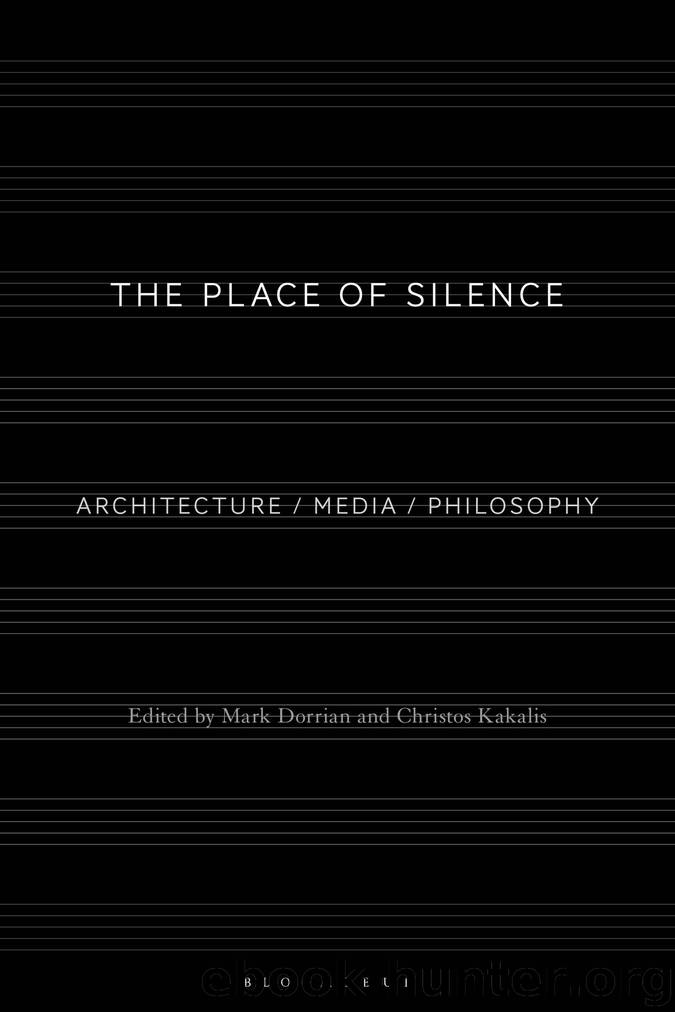The Place of Silence by Mark Dorrian;Christos Kakalis;

Author:Mark Dorrian;Christos Kakalis;
Language: eng
Format: epub
ISBN: 9781350076617
Publisher: Bloomsbury UK
Published: 2019-12-02T16:00:00+00:00
Materiality of silence
When the German philosopher Gernot Böhme recalls ‘entering silence as if walking into a wall of fog’ at the threshold of Cologne cathedral,10 he describes an experience of spatial articulation without walls or other solid material elements. This silence is not soundlessness – it is a density that rises up above the muffled sounds of the city outside, which actually articulate the silence. Like the sublime, silence is a contrastive experience, most clearly apprehended at a moment of ingress, ‘through experiencing the contrast when entering from a different atmosphere’.11 And then, the potent density of the interior’s silence combines with the upward pull of the nave on the viewer’s gaze. Sensing the immensity of space triggers an awareness of one’s own body, one’s smallness in space. ‘Feelings alternate between slipping into infinity and being thrown back upon one’s body’, making palpable one’s own ‘lost, disoriented presence, in an over-large space’.12 To feel a small part of something much larger creates connections with the world, and beyond that the universe, in the present, past and future. An original medium becomes palpable, an atmosphere, which is not just ‘something relational’ but ‘the relation itself’.13 An atmosphere of silence, of stillness, opens toward this experience. In Old English, still meant ‘motionless, stable, fixed, stationary’, and later ‘quiet, calm, gentle, silent’.14 The latter meaning endures as that of still in German, while Stille translates into English as ‘silence’. The close connection between sound and movement is evident in the Oxford online dictionary’s definition of still: ‘Not moving or making a sound.’15 Thus, Böhme says that one becomes aware of the silence in the cathedral through the sound of one’s footsteps. Does this awareness stop, though, when one comes to a standstill?
In public ritual and event – in assemblies, performances, processions and demonstrations – this highly affective experience of silence as a quasi-stuff not only serves to mark time and occasion but also to provide spatial structure. Depending on context, it can solidify aural and gestural stillness or create anticipation and an orientation toward the future. This duality resonates with the relation of silence to intensified inwardness as well as outwardness, or with the simultaneous or alternating receptiveness to the world and reflection on the soul. Either way, silence can focus the attention of a collective towards a particular place and point in time.
During her adolescence, one of the authors of this chapter participated in many early morning processions at a Catholic boarding school in the Rhineland, Germany. The order, Sisters of Notre Dame, celebrated the months of May and October in honour of holy Mary with daily dawn processions in the cloister gardens. For an hour or so, about seventy girls and thirty nuns sang, walked, prayed and stood silent in the promising May atmosphere or the sometimes-melancholic mood of October. There was to be no chatter and no sudden, uncoordinated movements. A precisely worked-out choreography, reminiscent of strategies for the design of scenes developed by Christian Cay Lorenz Hirschfeld, the eighteenth-century theorist of ‘garden art’,16 gradually unfolded and with it a carefully patterned space.
Download
This site does not store any files on its server. We only index and link to content provided by other sites. Please contact the content providers to delete copyright contents if any and email us, we'll remove relevant links or contents immediately.
Kathy Andrews Collection by Kathy Andrews(11463)
The remains of the day by Kazuo Ishiguro(8550)
Paper Towns by Green John(4894)
Spare by Prince Harry The Duke of Sussex(4874)
Industrial Automation from Scratch: A hands-on guide to using sensors, actuators, PLCs, HMIs, and SCADA to automate industrial processes by Olushola Akande(4715)
The Body: A Guide for Occupants by Bill Bryson(4710)
Machine Learning at Scale with H2O by Gregory Keys | David Whiting(3785)
Be in a Treehouse by Pete Nelson(3729)
Harry Potter and the Goblet Of Fire by J.K. Rowling(3656)
Never by Ken Follett(3610)
Goodbye Paradise(3532)
The Remains of the Day by Kazuo Ishiguro(3180)
Into Thin Air by Jon Krakauer(3176)
The Cellar by Natasha Preston(3128)
The Genius of Japanese Carpentry by Azby Brown(3099)
Fairy Tale by Stephen King(3048)
120 Days of Sodom by Marquis de Sade(3013)
Drawing Shortcuts: Developing Quick Drawing Skills Using Today's Technology by Leggitt Jim(2947)
The Man Who Died Twice by Richard Osman(2873)
